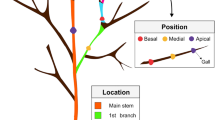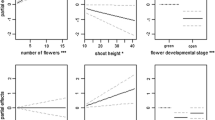Summary
Variability within and between shoots of the grass Phragmites australis proved to be important for both survival (successful gall induction) and reproduction (larval weight) of the gall-inducing midge Giraudiella inclusa. The ovipositing females and the migrating first instar larvae chose a predictable microhabitat within shoots and within internodes characterized by a high nutritional quality (nitrogen, mineral content, sugar, water) and reduced palnt defense properties (silicate). Clutch size increased with the shoot diameter, larval scramble competition could not be detected. Female shoot selection was random, although the chances of successful gall induction greatly differed between shoots. Thick and intact shoots (≥6 mm) led to a high larval mortality. But thick shoots destroyed apically by stem-mining caterpillars (of the noctuid moth Archanara geminipuncta) had on average large gall clusters. Accordingly, the adjustment of the clutch size to the shoot diameter resulted in an advantage for the gall midge females only when shoots were thin and short (i.e. stressed by water and nutrient deficiency) or heavily damage (i.e. stressed) by caterpillars. Thus, the monophagous gall maker G. inclusa did not compensate for all features of intershoot variation of P. australis, although grasses are well-known for their simple plant architecture and their low diversity and low concentration of secondary compounds.
Similar content being viewed by others
References
Åhman J (1986) Oviposition in Dasineura brassicae Winn. (Dipt.: Cecidomyiidae). Adaptive, mechanistic, and applied aspects. Plant Prot Rep 9, Dep Plant For Prot, Swedish Univ Agric Sci, Uppsala
Askew RR (1962) The distribution of galls of Neuroterus (Hymenoptera, Cynipidae) on oak. J Anim Ecol 31:439–455
Bassler R, Putzka HA (1972) Über die Zusammensetzung von Nebenerzeugnissen der Reisbearbeitung. Landwirtsch Forsch Sonderheft 27/II:24–29
Bernays EA, Barbehenn R (1987) Nutritional ecology of grass foliage-chewing insects. In: Slansky F Jr, Rodriguez JG (eds) Nutritional ecology of insects, mites, spiders, and related invertebrates. J Wiley, New York, pp 147–175
Björk J (1967) Ecological investigations of Phragmites communis. Folia limnol scand 14:1–248
Bultman TL, Faeth SH (1987) Impact of irrigation and experimental drought stress on leaf-mining insects of Emory oak. Oikos 48:5–10
Culvenor CCJ (1970) Toxic plants — a reevaluation. Search 1(3):103–110
Denno RF (1983) Tracking variable host plants in space and time. In: Denno RF, McClure MS (eds) Variable plants and herbivores in natural and managed systems. Academic Press, New York, pp 291–341
Denno RF, McClure MS (eds) (1983) Variable plants and herbivores in natural and managed systems. Academic Press, New York
Denno RF, Paupp MJ, Tallamy DW, Reichelderfer CF (1980) Migration in heterogeneous environments: differences in habitat selection between the wing forms of the dimorphic plant hopper, Prokelisia marginata (Homoptera: Delphacidae). Ecology 61:859–867
Djamin A, Pathak MD (1967) Role of silica in resistance to asiatic rice borer, Chilo suppressalis (Walker), in rice varieties. J Econ Entomol 60:347–351
Fedde GF (1973) Impact of the balsam woolly aphid (Homoptera: Physlloxeridae) on cones and seed produced by infested fraser fir. Canad Entomol 105(5):673–680
Feeny P (1970) Seasonal changes in oak leaf tannins and nutrients as a cause of spring feeding by winter moth caterpillars. Ecology 51(4):565–581
Frankie GW, Morgan DL (1984) Role of host plant and parasites in regulating herbivore populations. In: Price PW, Slobodchikoff CN, Gaud WS (eds) A new ecology: Novel approaches to interactive systems. J Wiley, New York, pp 101–140
Gorham E, Pearsall WH (1956) Production ecology. III. Shoot production in Phragmites in relation to habitat. Oikos 7:206–214
Harris P (1980) Effects of Urophora affinis Frfld. and U. quadrifasciata (Meig.) (Diptera: Tephritidae) in Centaurea diffusa Lam. and C. maculosa (Compositae). J Appl Entomol 90:190–201
Haslam SM (1969) The development of shoots in Phragmites communis Trin. Ann Bot 33:695–709
Haslam SM (1970) The performance of Phragmites communis Trin. in relation to water supply. Ann Bot 34:867–877
Haslam SM (1971) Shoot height and density in Phragmites stands. Hidrobiol Bucuresti 12:113–119
Ho YB (1979) Shoot development and production studies of Phragmites australis (Cav.) Trin. ex Steudel in Scottish lochs. Hydrobiologia 64(3):215–222
Lawton JH (1976) The structure of the arthropod community on bracken. Bot J Linn Soc 73:187–216
Lawton JH (1983) Plant architecture and the diversity of phytophagous insects. Ann Rev Entomol 28:23–39
Lewis AC (1982) Conditions of feeding preference for wilted sunflower in the grasshopper Melanoplus differentialis. Proc 5th Symp Insect-Plant Relationships, Wageningen 1982, Pudoc Wagenigen, 49–56
Maddox GD, Root RB (1987) Resistance to 16 diverse species of herbivorous insects within a population of goldenrod, Solidago altissima: genetic variation and heritability. Oecologia 72:8–14
Mattson WJ, Haack RA (1987) The role of drought in outbreaks of plant-eating insects. Bio Science 37(2):110–118
McClure MS (1983) Competition between herbivores and increased resource heterogeneity. In: Denno RF, McClure MS (eds) Variable plants and herbivores in natural and managed systems. Academic press, New York, 125–153
McNaughton SJ, Tarrants JL, McNaughton MM, Davis RH (1985) Silica as a defense against herbivory and a growth promoter in african grasses. Ecology 66(2):528–535
McNeill S, Southwood TRE (1978) The role of nitrogen in the development of insect/plant-relationships. In: Harborne JB (ed) Biochemical aspects of plant and animal coevolution, Academic Press, London, pp 77–98
Michels GJ, Undersander DJ (1986) Temporal and spatial distribution of the greenbug (Homoptera: Aphididae) on Sorghum in relation to water stress. J Econ Entomol 79:1221–1225
Mook JH (1967) Habitat selection by Lipara lucens Mg (Diptera, Chloropidae) and its survival value. Arch Neerl Zool 17(4):469–549
Mook JH (1971) Influence of environment on some insects attacking common reed (Phragmites communis Trin.). Hidrobiol 12:305–312
Mook JH, Van der Toorn J (1982) The influence of environmental factors and management on stands of Phragmites australis. II. Effects on yield and its relationships with shoot density. J Appl Ecol 19:501–517
Mook JH, Van der Toorn J (1985) Delayed response of common reed Phragmites australis to herbivory as a cause of cyclic fluctuations in the density of the moth Archanara geminipuncta. Oikos 44:142–148
Moore D (1984) The role of silica in protecting ryegrass (Lolium multiflorum) from attack by dipterous stem-boring larvae (Oscinella frit and other related species). Ann Appl Biol 104:161–166
Naumann C, Bassler R (1976) Die chemische Untersuchung von Futtermitteln. In: Siegel O (ed) Handbuch der landwirtschaftlichen Versuchs- und Unttersuchungsmethodik (Methodenbuch; mit 1. Ergänzungslieferung 1983), Bd. III, Neumann-Neudamm, Melsungen
Prestige RA, McNeill S (1983) Auchenorrhyncha-host plant interactions: leafhoppers and grasses. Ecol Entomol 8:331–339
Price PW (1985) Research questions in ecology relating to community ecology, plant-herbivore interactions, and insect ecology in general. In: Cooley JH, Golley FB (eds) Trends in ecological research for the 1980s, Plenum Press, New York, pp 75–88
Rhoades DF (1985) Offensive-defensive interactions between herbivores and plants: their relevance in herbivore population dynamics and ecological theory. Am Nat 125:205–238
Podewald-Rudescu L (1974) Das Schilfrohr Phragmites communis Trinius. In: Elster HJ (ed) Die Binnengewässer Bd. 27, Schweizerbartsche Verlag, Stuttgart, pp 1–302
Rohfritsch O (1975) Etude du development de la galle de Giraudiella inclusa Fr sur Phragmites communis Trin.. Marcellia 38:251–270
Rohfritsch O, Shorthouse JD (1982) Insect galls. In: Schell J, Kahl G (eds), Molecular biology of plant tumors. Academic Press, New York, pp 131–152
Schröder D (1967) Diplolepis (Rhodites) rosae (L.) (Hymenoptera, Cynipidae) and a review of its parasite complex in Europe. Techn Bull (Commonwealth Inst Biol Contr) 9:93–131
Scriber JM, Slansky F (1981) The nutritional ecology of immature insects. Ann Rev Entomol 26:183–211
Skinner SW (1985) Clutch size as an optimal foraging problem for insects. Behav Ecol Sociobiol 17:231–238
Skuhrava M, Skuhravy V (1981) Die Gallmücken (Cecidomyiidae, Diptera) des Schilfs (Phragmites communis). Studie CSAV, Prag 3:1–150
Sokal RR, Rohlf F (1981) Biometry, 2nd ed., Freeman, New York, p 859
Sone K (1985) Gregariousness and devepment of larvae of the pine ncedle gall midge, Thecodiplosis japonensis Uchida et Inouye (Diptera, Cecidomyiidae), in a gall. Appl Entomol Zool 20(4):431–438
Sone K, Takeda H (1983) Studies on the distribution pattern of the pine needle gall midge, Thecodiplosis japonensis Uchida et Inouye (Diptera: Cecidomyiidae) in a pine forest. Res Popul Ecol 25(2):336–352
Southwood TRE (1977) Habitat, the templet for ecological strategies? J Anim Ecol 46:337–365
Southwood TRE, Jepson WF (1962) Studies on the populations of Oscinella frit L. (Diptera, Chloropidae) in the oat crop. J Anim Ecol 31:481–495
Stille B (1984) The effect of hostplant and parasitoids on the reproductive success of the parthenogenetic gall wasp Diplolepis rosae (Hymenoptera, Cynipidae). Oecologia (Berlin) 63:364–369
Szczepanska W, Szczepansky A (1973) Emergent macrophytes and their role in wetland ecosystems. Pol Arch Hydrobiol 20(1):41–50
Szczepanska W, Szczepansky A (1976) Growth of Phragmites communis Trin., Typha latifolia L., and Typha angustifolia L. in relation to the fertility of soils. Pol Arch Hydrobiol 23(2):233–248
Taper ML, Zimmermann EM, Case TJ (1986) Sources of mortality for a cynipid gall-wasp (Dryocosomus dubiosus, Hymenoptera: Cynipidae): The importance of the tannin/fungus-interaction. Oecologia (Berlin) 68:437–445
Tscharntke T (1986) Die Gallmücke Giraudiella inclusa (Diptera, Cecidomyiidae) im Nahrungsnetz des Ökosystems Schilf (Phragmites australis): Wechselwirkungen zwischen den Populationen von vier tropischen Ebenen. Dissertation, Fachbereich Biologie, Universität Hamburg, pp 135
Tscharntke T (1987) Growth regulation of Phragmites australis by the gall midge Giraudiella inclusa. In: Labeyrie V, Fabres G, Lachaise D (eds), Insects-Plants, W Junk Publ, Dordrecht, Entomol Ser 41:201–205
Turin-van den Burg A (1977) Waarnemingen over de rietgalmug Giraudiella inclusa Gir in verband met de eigenschappen van het riet Phragmites communis Trin.. Internal Stud Rep, Inst Ecol Res, NL-Heteren 13:1–19
Van der Toorn J (1972) Variability of Phragmites australis (Cav) Trin ex Steudel in relation to the environment. Van Zee tot Land 48:1–122
Van der Toorn J, Mook JH (1982) The infleunce of environmental factors and management on stands of Phragmites australis. I. Effects of burning, frost, and insect damage on shoot density and shoot size. J Appl Ecol 19:477–499
Vickerman GP (1978) Survival and duration of development of Oscinella spp (Diptera, Chloropidae) on different Gramineae in the laboratory. Ann Appl Biol 89:387–393
Waquil JM, Teetes GL, Peterson GC (1986a) Adult sorghum midge (Diptera: Cecidomyiidae) nonpreference for a resistant hybrid sorghum. J Econ Entomol 79:455–458
Waquil JM, Teetes GL, Peterson GC (1986b) Sorghum midge (Diptera: Cecidomyiidae) adult ovipositional behaviour on resistant and susceptible sorghum hybrids. J Econ Entomol 79:530–532
Waquil JM, Teetes GL, Peterson GC (1986c) Comparison of immature sorghum midge (Diptera: Cecidomyiidae) development on resistant and susceptible sorghums. J Econ Entomol 79(3):833–837
Weis AE, Price PW, Lynch M (1983) Selective pressures on clutch size in the gallmaker Asteromyia carbonifera (Diptera, Cecidomyiidae). Ecology 64(4):688–695
Whitham TG (1983) Host manipulation of parasites: Within-plant variation as a defense against rapidly evolving pests. In: Denno RF, McClure MS (eds) Variable plants and herbivores in natural and managed systems. Academic Press, New York, pp 15–41
Whitham TG, Williams AG, Robinson AM (1984) The variation principle: Individual plants as temporal and spatial mosaics of resistance to rapidly evolving pests. In: PW Price, CN Slobodchikoff, WS Gaud (eds) A new ecology: Novel approaches to interactive systems, J Wiley, New York, pp 15–51
Williams KS, Myers JH (1984) Previbus herbivore attack of red alder may improve food quality for fall webworm larvae. Oecologia 63:166–170
Zwölfer H (1985) Energieflußsteuerung durch informationelle Prozesse — ein vernachlässigtes Gebiet der Ökosystemforschung. Verh Ges Ökologie, Bremen 1983 12:285–294
Author information
Authors and Affiliations
Rights and permissions
About this article
Cite this article
Tscharntke, T. Variability of the grass Phragmites australis in relation to the behaviour and mortality of the gall-inducing midge Giraudiella inclusa (Diptera, Cecidomyiidae). Oecologia 76, 504–512 (1988). https://doi.org/10.1007/BF00397861
Received:
Issue Date:
DOI: https://doi.org/10.1007/BF00397861




